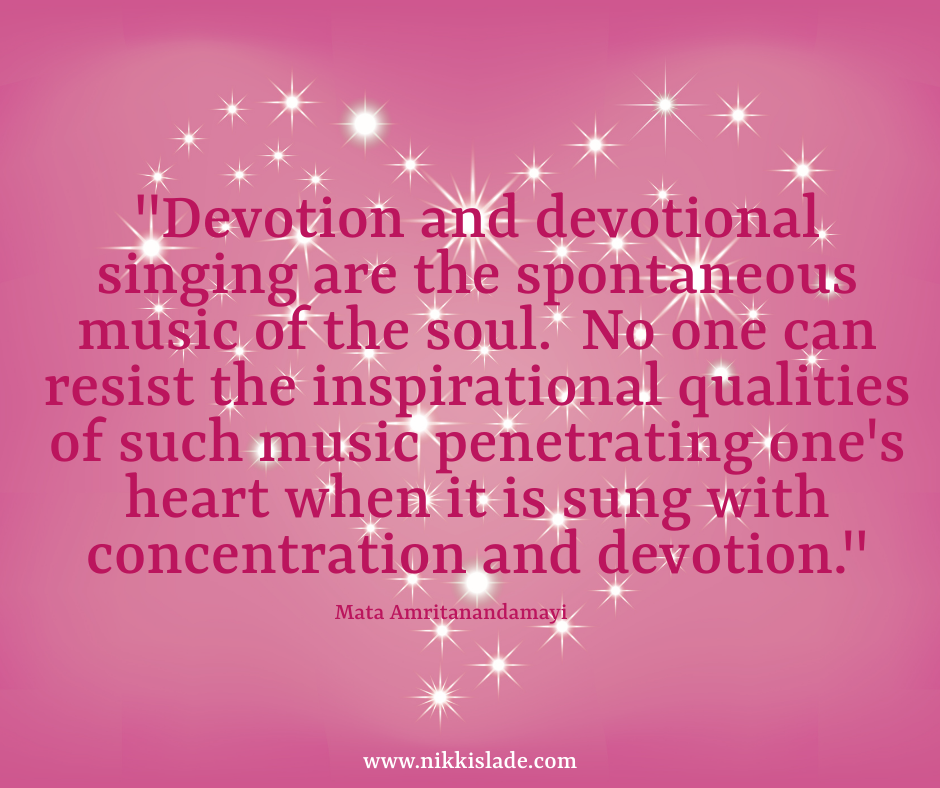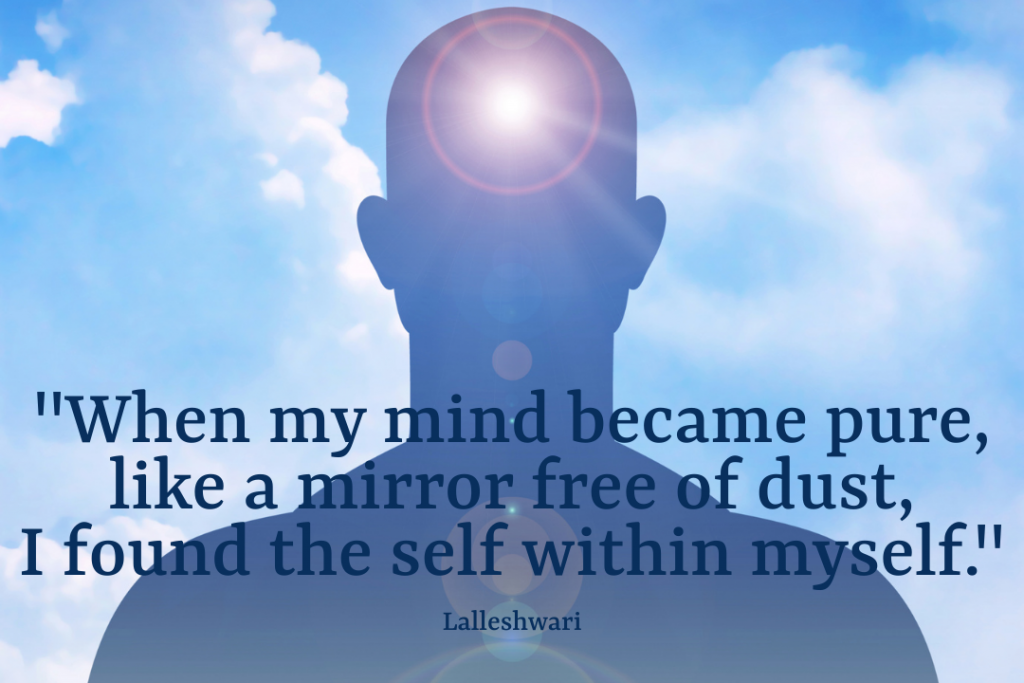Chanting is the Yoga of Sound

(first published in Yoga Magazine)
Yogic masters throughout the ages have told us that the purpose of yoga is to ‘know the self’ (the light of consciousness that radiates within). In truth, the sages say that the Self is already attained and when we turn deep within, we experience our true nature which is blissful and free.
In the practice of chanting mantras we connect with that primordial vibration of inner freedom and we become alive! Chanting opens the heart cleanses the mind and uplifts the spirits. In this age of Kali Yuga, the age of
darkness, the sages say that chanting is the perfect practice for inner
transformation during these dark times that we live in. In the practice
of Bhakti yoga, we chant mantras with full devotion or “bhakti”. Mantra means instrument of the mind. The mantras we chant are in Sanskrit which centuries ago was a colloquial language. Over the past 1400 years, Sanskrit has been preserved wholly for sacred practice. Naturally there is an intrinsic purity to the Sanskrit language and in truth what brings the sacred syllables alive is the yogis devotion when he or she is chanting.
The great Persian poet saint Rumi once wrote
“Let yourself be silently drawn by the stronger pull of what you really love.”
This is the yogi’s experience when she/he is filled with devotion. One of the main practices of Bhakti yoga is Kirtan or nama-sankirtana which means to ‘Sing the Name’.
The name of what you may ask?
The answer is the name of the divine principle as you understand it. The origin of Kirtan practice stems back to 7th century, India in the Tamil Nadu region with the poet saint movement which began with the arrival of the Alvars and the Nayanars. These were mystical beings who sought enlightenment through meditation. Waves of divine ecstasy would arise as they deeply connected to the universe within them and they wrote expressive poetry about the supreme state they had tapped into and the longing or devotion (bhakti)they had for God. These great mystics transcended religious dogma and found liberation within. The poet saints travelled hundreds of miles sharing their poetry and sacred songs known asabhangars` throughout the market places. They touched the hearts of the poorest people known as Shudras or low castes with their wise inspiring and uplifting words. These souls were not accepted into the main temples by the Brahmin priests because of their poverty so when they heard from the poet saints that the true temple dwelled in their heart and that they could find God inside, they were overjoyed! They began to sing and dance in the streets creating a melody to some of the words from the poems they had heard recited, for example, Om Namah Shivaya or Sri Ram Jay Ram; hence Kirtan naturally emerged.

Some of the greatest poet saints include Tukaram Maharaj, Kabir Guru
Nanak, Mirabai, Surdass, Lalleshwari and Tulsidas. Some of these saints
practiced Nirguna worship meaning that they did not focus on a specific
form of the divine such as Krishna or Shiva they would instead choose one
word, e.g., Ram as was the focus for Kabir (not to be confused with Lord
Rama in the Ramayana epic Indian tale). Kabir resonated with the word
Ram and he would chant it daily with full devotion to his mantra and over
time, he became liberated from the human bondage to the mind and body.
He wrote:
“All know that the drop merges into the ocean but few know that the ocean merges into the drop!”
Kabir recited the mantra Ram through which he discovered the primordial
vibration of divine love where for him all names and forms ultimately
dissolved.
The other type of practice for the poet saints was Saguna worship where they would focus one pointedly on one specific name or form to access
the supreme state. One such being was Mirabai who was totally devoted to
Lord Krishna but not in the religious sense in truth to the contrary. Mirabai
broke ties with her controlling religious family and immersed herself with Lord Krishna whom she loved with her whole heart, that over time her devotion was so strong that she merged with Krishna’s ecstatic state and she became One with divine Love.
This quote from Mirabai illustrates her wild devotion and is echoed by many of the poet saints.
“I am mad with love and no-one understands my plight. Only the wounded understand the agonies of the wounded, when the fire rages in the heart.”
In the present day, the beauty of Bhakti yoga is that it is a natural practice that is open to everyone and is attained by our innate longing to go home within. As we focus on the syllables of each chant with full devotion, we experience the pull of the inner Self drawing the mind back to its Self like a river merging back into the ocean. In Bhakti yoga we are not obliged to follow any specific faith tradition, but rather to discover our own sacred connection. Many people in the yoga world ask whether practicing Kirtan implies that they must follow Hinduism which is not the case. In yoga, it is important that we respect the Hindu faith and all traditions whether Muslim, Christian, Jewish or Buddhist, etc. That said, it is important that each individual comes to find their own unique relationship to the divine that resonates for them which may not include any specific tradition.

As a Kirtan leader within Bhakti yoga for over 30 years, it has always been an enormous privilege to welcome into the yoga community gatherings of all faiths. When I give instruction at the start of a session, I always encourage everyone to bring their own unique connection to the mantras we chant such as Om Namah Shivaya. For example, for a chanter of Hindu faith, this for him will mean Lord Shiva (a blue God, the creator and the destroyer). For many other chanters, this mantra will transcend the focus of a specific form and will mean merging directly with divine awareness, spaciousness and consciousness. This is kindred to the Nirguna worship of Kabir mentioned earlier where the chanter focuses directly on the source of core divine vibration itself. Some chanters who attend may be Christian or Muslim in which case when they chant, I invite them to bring the form of the divine that is true for them. For some it may simply be about focusing on Mother Nature herself.
The beautiful truth about the yoga of chanting is that we can all be together under one roof singing the name of the beloved of our own understanding.
In conclusion, Bhakti yoga is a broad church that encourages everyone to discover their own way at the same time respecting all faiths and cultures.
We have the good fortune to chant sublime mantras that dissolve the barriers to our inner light and guide us through form to the formless and from the finite to the infinite. Rumi said,
“There is a field, a singing field, I will meet you there.”
Om Namah Shivaya. Namaste!
Join me every Thursday, Friday and Saturday for virtual Kirtan. Full info here.







